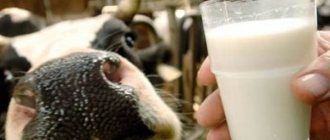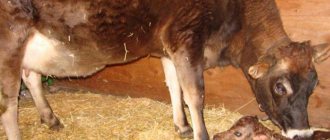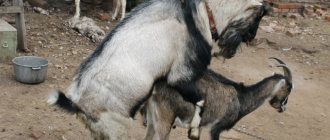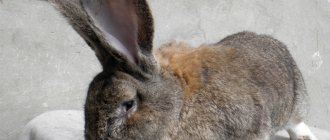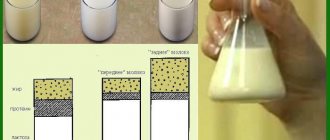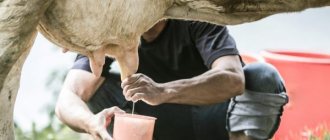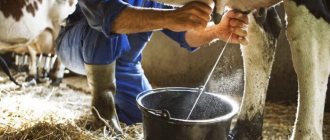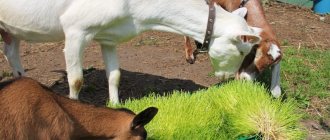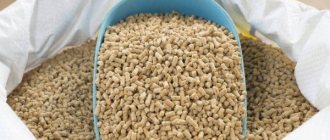General information
One of the most important conditions to follow is to ensure a balanced diet. The products a cow eats directly affect the quality, composition and fat content of milk. If a cow eats some root vegetables and plants, an unpleasant bitterness appears in the milk. The cow begins to have digestive tract disorders. Therefore, it is necessary to provide only those feeds that will not have a negative effect on the animal’s body and milk yield.
When calculating the volume of feed, it is necessary to take into account the time of year. There are certain factors that influence the amount of dairy products:
- the time when the female calved;
- season;
- age category;
- quality and composition of the diet;
- content features;
- correctness of the regime.
The average milk yield of one female in winter is about 15 liters. By providing quality nutrition and proper care, these indicators can be increased by a third. The richer the food, the higher the fat content will be. In addition to the fact that the diet must contain all the necessary vitamins and microelements, liquid food, sugar beets, and root vegetables must be present. The animal needs to be provided with the correct drinking regime.
How to increase milk yield in cows in winter
With the onset of cold weather, cows need careful care. The main thing is to prepare a room for them in advance and stock up on a variety of food, otherwise your cow will produce less milk. Denis Pilipenko, a researcher at the Volga Region Research Institute for the Production and Processing of Meat and Dairy Products, will talk about how to properly prepare for the wintering of cattle.
“In the fall, you need to prepare a room where the cow will spend the winter,” he advises. – Seal all the cracks and stock up on bedding (straw, sawdust) in advance so that the barn is always dry and clean, otherwise the animals may develop colds and other diseases.
In winter, two methods of keeping cows are used - with daily manure removal and without cleaning (when the bedding is changed daily, and the manure is removed only in the spring). If there is little litter, then the manure is removed daily. In order for a cow to milk well, she, in addition to everything else, needs proper and balanced nutrition.
“The winter diet should be balanced,” explains the specialist. – In addition to hay, haylage and silage, cows are given concentrates that can increase milk yield. Be sure to follow the conditions for their storage; they must be in well-ventilated and dry areas. Raw and cooked potatoes also increase milk production in livestock. At the same time, it needs to be washed and crushed well. You can give up to 15 kg of potatoes per day.
The diet of a dairy cow in winter must contain grain - barley and oats - this is a good source of energy. But it should not be spoiled or show signs of rotting. You can add bran and feed, vegetable peelings, and small bread crusts to the grain. On average, a cow can eat up to 50 kg of feed per day. If possible, add special vitamin complexes to their food.
“Silage is a mandatory ingredient in the Burenka menu,” the specialist reminds. – It must be of high quality, otherwise it will spoil the taste of the milk. Silage is a complete, juicy and nutritious feed made from grass, corn and root crop tops. Its daily dose for a cow is about 15 kg. The most common food in winter is hay (12 kg per day), to which 250–350 g of cake can be added daily.
According to the expert, straw is less nutritious, but is well digested by ruminants, so it is given in 5 kg doses. The most valuable in terms of nutritional value and digestibility are barley and oat straw. In clear weather, the cow can be released outside, since the sun's rays help increase lactation, and fresh air increases appetite, which leads to increased milk yield.
The cow should always have clean water at least +15 degrees within reach. Cold water can lead to animal illness and a decrease in milk production. If you follow all the rules for keeping cows in winter, you can achieve their high milk productivity and significantly improve the health of the cow.
Lyudmila BREUSOVA.
Photo by Alexander KULIKOV
What feed to use
It is important that the animal does not starve, otherwise lactation will not be abundant and the milk will not be fatty. After calving, adequate nutrition must be provided. The following products should be present in the diet:
- potatoes, they need to be chopped;
- cabbage, carrots, corn and turnips;
- cake, soybean grain, meal;
- fresh grass, silage, hay, straw;
- buttermilk, whey;
- feed sulfur;
- concentrated dietary supplements;
- salt and chalk – 50 grams per day.
The menu should be varied; all proportions of juicy products and additives must also be observed. The menu should also include calcium, phosphorus, and proteins. Paying due attention to nutrition is required in winter. Hay must be prepared correctly; it should not be wet, rotten or rotten.
To increase milk yield, you need to feed concentrated feed. These are grains and food industry waste, premixes, vitamin substances. Products such as milk powder and meat and bone meal will bring great benefits to the cow's body. There are ready-made feeds for cows on sale. They should be on the daily menu. Some of them are used if the body is weakened or there is a deficiency of vitamins.
If an animal is systematically overfed, various pathogenic microorganisms begin to develop in the organs of the digestive system. This is manifested by increased acidity and bloating, poor appetite, and difficulty breathing. In this case, you will need gastric lavage and control over your further diet.
We increase milk yield with feed
It is difficult to identify the main indicators due to which a cow produces more milk. But you should start with nutrition. The food eaten by the animal ends up in a can with the product. They partially influence the taste, composition, fat content and microelements of the nutrient fluid. Some plants and root vegetables add bitterness to milk, some lead to indigestion and loss of gum. You need to choose those from which the volume of the product increases and the quality does not suffer.
What to feed?
Of course, a hungry cow will still give milk if she develops a milk let-down reflex.
But its quantity will not please the livestock breeder. So, what is useful to give to a cow, especially in the postpartum period, when more milk is coming.
- finely chopped potatoes, cabbage, carrots, turnips, corn, pulp - about twenty kilograms;
- cake, soybean grain and meal as a source of proteins;
- fresh grass, hay, silage, less often steamed straw;
- buttermilk, whey;
- feed sulfur;
- concentrates - less than half of the total volume per day;
- approximately fifty grams of salt and the same amount of chalk per day, if mineral supplements are not present in the diet.
Variety is important in the diet, maintaining proportions in coarse, juicy foods and concentrates. Sugar, calcium, phosphorus, and protein should be given in proper quantities. Monitor this more closely during the stall period. The harvested hay is prepared correctly, not allowed to get wet, so that there is no smell or taste of rot.
Concentrated feed is given to increase milk yield. They represent grain and food industry waste, premixes, and vitamins. For example, meat and bone meal and milk powder are beneficial for cows.
More on the topic: Symptoms of paresis in a cow after calving and its treatment
You can purchase special feed for milking cows. Some of them are included in the daily diet of cattle. Others only when the body is weakened or there is a lack of substances.
Don't be too zealous when feeding animals. Concentrates are saturated with carbohydrates, their excess leads to disturbances in the functioning of the digestive system.
If overfeeding occurs, then the time of harmful bacteria comes. The cow notices bloating due to increased acidity and difficulty breathing. She needs to rinse her stomach.
How to feed?
You need to give food by the hour, several times a day, but little by little. Do not forget to give clean warm water to drink, sometimes slightly salted water. There should be plenty of liquid.
There is a certain set of rules on how to increase milk from a cow using feed:
- after childbirth, hay with cereals and legumes (up to two-thirds of the total amount of food);
- after three days, concentrates are gradually introduced;
- Root crops and silage are also given in doses. It takes time for an animal to get used to new food. After calving, about fourteen days have passed;
- The more actively the cow begins to milk, the greater the volume of feed.
According to rough estimates, fifteen kilograms of food are spent per kilogram of animal weight. Do not forget that compound feeds are easily digested, so increase their dose.
If the weight of a cow is half a ton, its average daily milk yield is sixteen liters, then it is recommended to give it:
- five kg of hay;
- six kg of haylage;
- ten kg silage;
- root vegetables up to seventeen kg;
- feed five kg;
- lie a hundred years
Based on these values, the dose of one or another component is increased or decreased. When the cow leaves food, the volumes can be made smaller.
Features of proper feeding
It is recommended to follow a diet, giving food at the same time every day. Portions should not be too large. It is necessary to give the animal clean drinking water. It is recommended to add table salt. You should not spare water for the cow, she must drink. There are certain nuances that must be observed in order to increase milk yield:
- two thirds of the portion after calving consists of hay and legumes, cereals;
- three days after calving, concentrates are gradually added to the feed;
- Root vegetables and silage are also fed sparingly, no earlier than two weeks after the female calves;
- The more milk you get per day, the larger the portions should be.
If an animal's average body weight is 500 kilograms, its average milk yield per day is about 16 liters. To maintain these indicators, you need to feed the following amount of food:
- hay - about 5 kilograms;
- haylage - 6 kilograms;
- silage – 10 kilograms;
- root vegetables - up to 17 kilograms;
- mixed feed - about 5 kilograms;
- Salt should also be present - 100 grams.
Important! The amount of feed must be selected individually for each animal. If the cow does not eat the offered portion, less feed should be given.
What do experienced livestock breeders advise?
Cow cows need to organize a balanced diet, thus increasing their daily milk yield. Every day, one adult consumes up to 70 kilograms of food. The diet should contain the following types of food: hay, chaff, haylage, tubers. It is recommended to add root vegetables, cereals and legumes. To increase the volume of dairy products, the diet must also contain mixed feed and food waste.
The hay must be of high quality. This is a key component of the menu. To properly prepare hay, the grass must be mowed during the flowering period and dried in a ventilated, dry room. The menu should also include straw, wet grass, sunflower and corn silage. You need to add beets, carrots, potatoes, and oats to your diet.
In the summer, you need to walk the cows in the pasture. This way they will be provided with all the necessary nutrients, which they will receive along with green food. At the same time, you need to give food waste, bran, since they contain a large percentage of fiber necessary for the normal functioning of the digestive system.
Important! You should not give boiled food, since heat treatment destroys most of the nutritional components.
How to launch correctly
When milk yield increases, the female needs to be started correctly. About two months before the expected calving date, the milk supply decreases. During this period, the body accumulates strength for the upcoming birth. This is a signal that lactation will improve after calving. When your milk supply decreases, you need to create the right diet. Portion sizes are reduced:
- the portion of greens and silage is reduced;
- Hay remains the main component on the menu;
- do not produce root vegetables.
The cow should not starve because the baby needs to gain weight. Limit portions of succulent food and do not overfeed the female. Two weeks before calving, milk production stops altogether, at which time the usual diet is gradually resumed. After calving, cows produce large quantities of milk, so they will need larger portions than before.
Use of medications
The use of special drugs also takes place in cattle breeding. These agents influence the quantitative and qualitative composition of milk. In the production of livestock products they often use:
- premixes;
- bioactive additives;
- medicines;
- stimulant drugs.
Premixes containing selenium are considered the safest in dairy production. The active part of such supplements is live yeast, containing zinc and selenium in easily digestible compounds. The product should be used 14 days before the expected calving date in the amount recommended by the instructions. After the calf is born, the supplement is given every day for 100 days.
Among the huge number of drugs that can increase milk yield, each farmer chooses the one that is most convenient to use on the farm.
How to milk properly
With proper distribution, it will be possible to maintain good production performance in the future. In the first few days after calving, the calf is next to the mother. With its help, the udder develops as the milk comes in sharply. The calf should remain near the mother until she produces colostrum. When the period of regular milk begins, the cub is weaned. It is also necessary to adhere to the following rules during the milking period:
- The cow needs to be given a sufficient amount of clean water. On average, this volume varies within 100 liters.
- It is necessary to milk up to five times during the day, maintaining equal intervals between procedures. By constantly expressing milk, you will be able to increase your milk yield.
- The udder begins to be massaged even before birth. And when the milking period begins, such manipulations are a necessity. Massage is carried out before milking and at the end. This is the prevention of inflammatory processes, lactostasis, mastitis and stagnation.
- When milking, you need to use your entire fist, grasping the entire nipple, and not just its tip.
- In order to increase the amount of milk, it is necessary to express it completely during milking. Nothing should remain in the udder, since it will burn out and not be produced in the same quantity as it was originally. In addition, remaining milk leads to inflammatory processes and mastitis.
How to increase the fat content of milk in cows
The fat content of milk is influenced by the hereditary qualities of the cow.
It is well known that “red” breeds of cows are richer in milk than black-and-white ones. The fat content of milk is directly related to nutrition. First of all, a cow needs hay; its absence or a decrease in the norm significantly reduces the fat content of the milk. Silage
increases fat content only in combination with root vegetables, pumpkin, and zucchini, because they are rich in sugar and fiber, which have a positive effect on increasing fat in milk.
“Zdravur Mu-Mu” I want!
The fat content of milk is reduced
by excess concentrates
, straw, and beet tops. But bran, much less than grain feed, reduces the fat content of milk; cake and meal (sunflower and flaxseed) - increase.
By the way, many give concentrates to the cow before milking, but it is more correct to give them after, when the mammary gland is emptied, and then the glucose contained in the concentrates is processed into milk fat.
It is also necessary to monitor the mineral metabolism of the cow. For example, phosphorus and calcium contained in the feed have a good effect on both milk yield and the fat content of milk. Therefore, we recommend using a special additive “Krepkovit for cows and calves”
, containing calcium, phosphorus, sodium and sulfur in an optimal ratio. Table salt is also needed. Fodder and sugar beets increase the fat content of milk. Carrots are very useful for dairy cows.
The diet requires vitamins and premixes: for vitamin and mineral supplements, experts recommend “Zdravur Mu-Mu”
. This supplement contains exactly those vitamins and microelements that strengthen the health of the animal, which means that its products will be of high quality. Thanks to the best balance of nutrients in the diet, the cow produces milk that is nutritionally complete: scientific research has confirmed that milk increases the content of easily digestible vitamins and beneficial microelements (including vitamins A, E, group B, zinc, iodine, etc.)
The fat content of milk is also influenced by the conditions in which cows are kept. The barn should be dry and warm. With high humidity, the fat content of milk decreases. Walking is required, but the cow must walk actively, move, not freeze, but also not sweat. By the way, it has been noted that the fattest drops of milk are the last, so it is important to milk the cow carefully. This is a very affectionate creature that quickly gets used to humans. She develops habits of consistent milking, feeding and walking times. Therefore, strict adherence to the daily routine, gentle treatment of the animal, regular and even milking and udder care create conditions for obtaining high-quality milk, high milk yields, and strengthen the health of the cow.
By the way, caring for the udder includes a number of mandatory procedures: washing with warm water, wiping with a hard towel, lubricating the nipples after milking with boric petroleum jelly, or better yet, with Lyubava cream.
. This cream is already known to many housewives due to its remarkable properties: eliminates dry skin of the udder, gives it firmness and elasticity, accelerates the healing of scratches and cracks, relieves inflammation, reduces itching from insect bites, which has a positive effect on the behavior of the animal during milking: occurs fast and complete milk release.
Content Features
A properly formulated diet and proper milking technique are key tasks in increasing milk yield in cows. But to maintain the amount of milk, proper maintenance of the animal and its health are important. Most often, livestock farmers encounter various diseases in cows in the absence of proper care.
The barn must be ventilated and warm. There should be no drafts. Also, temperatures should not be allowed to be too high so that the animal does not spend its own resources on cooling the body or on warming itself. A cow should not be allowed to sleep on an empty, cold floor. It is necessary to have clean, dry, warm bedding; it needs to be changed regularly. Otherwise, mastitis or inflammation is guaranteed.
In winter, animals need to be walked, thanks to this their digestive system will function normally.
Types of premixes
Depending on the composition and production features, premixes for cows can be fed to animals in different forms: dry, in the form of aqueous solutions, or added to feed. Regardless of the method of introduction, mixtures must be present in the diet when fattening cattle and during milk production. Premixes can be divided into 5 types:
- Rich in vitamins and microelements. They are given when cows are highly productive. The composition and rates of administration of mixtures directly depend on the physiological state of the animal.
- Additives to increase milk yield. Such mixtures are saturated with lactobacilli, amino acids, and humic acids. When they are consumed, the stomach microflora of cows is normalized, so the consumed feed is better absorbed. The animal becomes stronger, immunity and productivity increase.
- To remove harmful substances. Cereals are treated with various chemicals before being fed into animal feed. These supplements are designed specifically to remove harmful substances from the body of cattle. A distinctive feature of the mixtures is the high content of absorbents.
- For fattening calves. Supplements contain iodine, selenium, manganese, vitamins B, A, E and other active substances necessary for the growth of the animal.
- Medicinal. Supplements are used to treat specific diseases. Unlike vitamin mixtures, they contain antibiotics necessary to combat a specific ailment.

